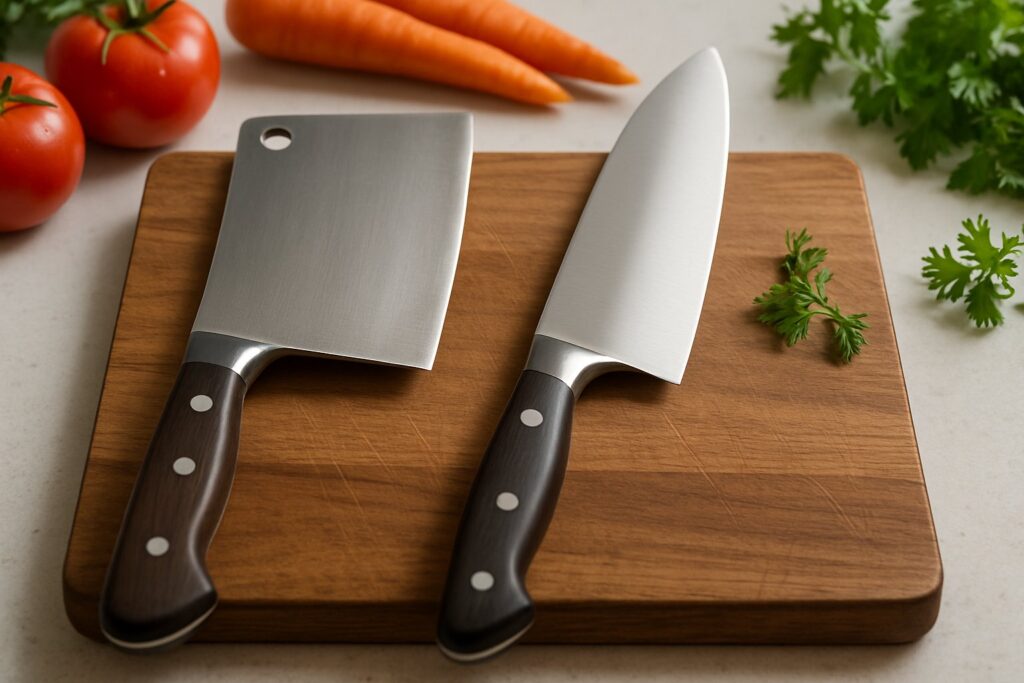
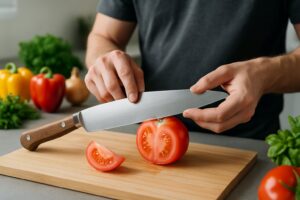

Deciding between a cleaver and a chef knife can really shake up your kitchen routine. Each knife has its own personality. If you want easy, precise slicing and dicing, reach for a chef knife. For tough chopping and cutting through bones, grab a cleaver.
The chef knife has a curved blade, perfect for rocking back and forth and making thin, even cuts. The cleaver, meanwhile, is famous for its thick, tough blade that can breeze through hard foods like bones or squash. Knowing when to grab each tool helps you get better results and keeps your knives in good shape.
The cleaver has a big, rectangular blade that is straight-edged, wide, and flat. It chops through bones, tough meat, and can even crush garlic or ginger with the flat side. The weighty blade is made for straight-down chopping.
Cleavers are heavy. That extra heft means gravity does some of the work for you. This mighty blade cuts through bones or dense veggies using less muscle. Most of the weight sits in the blade, so it packs a punch. The catch is that the cleaver isn’t nimble for fine cutting, slicing, or dicing.
While chef knives are longer than cleavers, the cleaver is much taller from spine to edge. This means that you get more cutting surface which is ideal for chopping hard root vegetables and large chunks of meat.
Chef knives, by contrast, feel well-balanced and easier to use. These knives usually have a curved blade that narrows to a sharp point. The curve lets you rock the blade for easy slicing or mincing of vegetables, fruit, and herbs. The blade is also thinner than a cleaver so it can do more detailed, precise cuts.
If you are prepping a larger meal you will appreciate the chef knife’s handling. They’re easier to control and lighter on your wrist. The ergonomic handle lets you keep a comfortable grip and avoid fatigue.
Some chef knives are made for delicate, repetitive slicing. If you’re dicing all day, their lighter, balanced feel is a real perk.
| Feature | Cleaver | Chef Knife |
| Length | 6-12 inches | 6-14 inches |
| Weight | Heavyweight | Lightweight |
| Construction | Forged | Forged or Stamped |
| Blade material | Stainless steel | Stainless steel, carbon steel, a laminate of the two metals, or ceramic |
| Bevel | Single | Single |
The chef knife is the classic all-rounder. You can slice, dice, mince, and chop—so it’s the go-to for most daily cooking. The curved edge and balanced weight make fast, precise cuts a breeze.
Cleavers, especially the Chinese cleaver, are surprisingly versatile, too. They handle dense veggies and meats, scoop up chopped stuff, and crush garlic with the flat blade. But they’re heavier, so getting comfortable with one takes a little practice.
Most cleavers and chef knives use stainless steel or carbon steel. Stainless steel resists rust and cleans up easily, but some folks swear by carbon steel for its sharpness, even if it’s fussier to maintain.
High-end blades sometimes use Damascus Steel, which is both tough and pretty to look at. Cleavers tend to be thicker and heavier for a reason. They need to survive forceful chopping. Chef knives are thinner, built for precision, but they’re not great with bone or super hard foods.
Blade edge retention varies across both knives. Cleavers, thanks to their thickness, can stay sharp longer if you use them right. Chef knives, with their finer edge, need more frequent sharpening.
Each knife brings its own strengths to the table. Picking the right one changes how you prep, how fast you work, and how your food turns out.
Chef knives are built for versatility. That curved blade lets you rock back and forth for smooth slicing and dicing veggies, fruit, herbs, you name it. You can control the thickness of your cuts easily.
Cleavers, with their wide, flat blade, shine at straight up-and-down chopping. They’re great for blasting through big piles of cabbage or root veggies, and the wide blade is perfect for scooping stuff off the board.
For precision slicing, chef knives win. If you’re tackling a tough squash or need raw power, the cleaver is your buddy. The way you cut changes how your food looks and cooks.
Both knives can mince, but they do it differently. The chef knife’s thin blade is a champ for mincing herbs, onions, and garlic. You can choke up on the blade for better control and finer cuts.
For crushing, nothing beats the cleaver’s broad side. Just lay the flat blade over garlic or nuts and press down. You can mince with a cleaver, but it’s usually chunkier and less uniform than with a chef knife.
If you’re constantly making fine, delicate cuts, go for the chef knife. For fast mincing and bulk crushing, the cleaver can be a real workhorse.
Need to hack through thick meat, cartilage, or small bones? The cleaver is made for that. Its heavy blade delivers the force you need for chicken backs, pork ribs, or anything tough. Butchers use them for a reason.
Chef knives just aren’t built for those heavy-duty jobs. The thin blade can bend or chip if you go at bones. Still, they’re great for trimming fat and slicing meat, raw or cooked, nice and clean.
If you break down whole chickens or big cuts of meat often, a cleaver makes sense. For most other jobs that need more finesse, the chef knife is safer and easier to control.
For most home cooks, a chef knife covers the bases. The cleaver is there when you need to handle bigger, tougher jobs.
In Chinese kitchens, the vegetable cleaver is a staple. You’ll see it used for chopping, slicing, and fine dicing. The wide blade scoops up food and moves it from board to wok. Chinese cleavers aren’t just for heavy chopping; lots of cooks use them for veggies, herbs, and even delicate proteins.
Western cooking leans on the chef knife for its multitasking ability. It’s great for trimming fat, portioning meat, and prepping veggies. The pointed tip comes in handy for detail work you’ll find in a lot of Western recipes.
Your cooking style should guide your pick. Love stir-fries or Chinese dishes? The cleaver’s broad blade is a plus. Prefer Western or all-purpose cooking? The chef knife is probably your best bet.
The way you use your knife matters just as much as which one you choose. Chef knives shine with the rocking motion—anchor the tip and move the handle up and down. It’s perfect for mincing herbs or dicing onions and helps you work efficiently.
The Chinese cleaver, meanwhile, is all about downward chopping. It slices, crushes garlic, and scoops up ingredients. Filleting, though, is tricky with a cleaver—the blade’s just too thick and straight. For delicate work like filleting fish, the chef knife’s slim blade gives you more control.
Comfort counts, too. Lighter chef knives are easier on your hands. Cleavers need a firmer grip, but their flat edge is handy for unique tasks. Trying different techniques with both can really expand your skills.
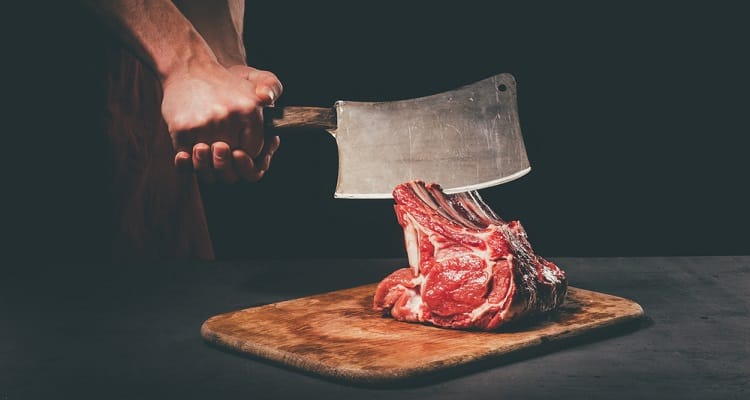
Choosing between a chef knife and a cleaver really comes down to what you cook most and what just feels right in your hand. Everyone has their favorite kitchen knives, and honestly, that’s half the fun.
The chef knife, with its curved, pointed blade, is basically your go-to for slicing, dicing, and chopping softer foods. It rocks easily on the board, gives you good control, and feels balanced. Most folks grab an 8-10 inch chef knife for daily prep—it just works for a ton of things.
Now, a cleaver is a totally different beast. It’s heavier, with a big rectangular blade that can smash through thick meat, bones, and those stubborn veggies. The flat side? Handy for crushing garlic or scooping up chopped bits. Sure, it’s not as nimble for delicate tasks, but if you’re often dealing with big or tough ingredients, it’s pretty much essential. Some cleavers—especially the Chinese-style ones—can handle both splitting and finer slicing.
So, what should you pick? It’s about what you like to cook, how much effort you want to put in, and what feels good in your hand. Size, balance, weight—these things matter more than people admit.
If you want your kitchen knives to stay sharp and stick around, you’ve got to treat them right.
Always wash chef knives and cleavers by hand—dishwashers are just too rough. Use a bit of mild soap, dry them off right away, and you’ll avoid rust or corrosion. Stash them in a knife block or on a magnetic strip to keep the edges safe. And please, use wood or plastic cutting boards—not glass or stone, unless you like dull blades.
Sharpening tips:
With a little regular care and the right maintenance tools, your knives will be ready for whatever you throw at them.
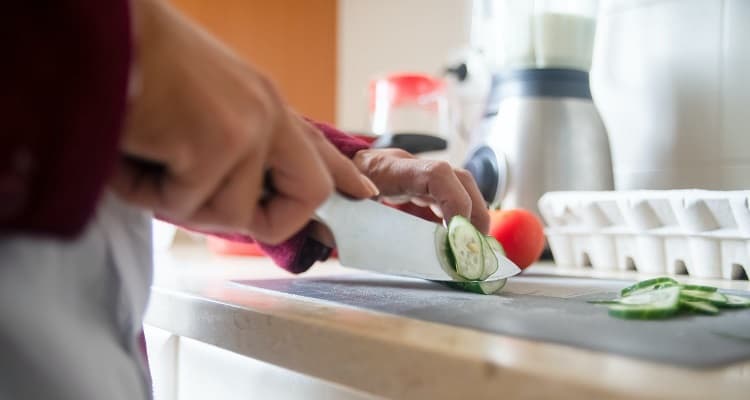
Cleavers and chef knives aren’t the same. They differ in blade shape, weight, and what they’re best at. The right one? Depends on what you’re cooking and how you like to cut.
The cleaver comes with a big, rectangular blade that’s heavy and strong. The cleaver is great for chopping through thick cuts, bones, or tough veggies. The knife’s weight does a lot of the work for you.
Chef knives, on the other hand, have long, curved blades. They make slicing, dicing, and mincing quick and easy, thanks to the rocking motion you can use. Honestly, most people find them more versatile for everyday kitchen stuff.
The Chinese cleaver, sometimes called a vegetable cleaver, shines when you’re slicing, mincing, or crushing lots of ingredients. It’s handy for prepping big batches of veggies or when you want to scoop everything up with the wide blade.
This cleaver is also great for crushing garlic or ginger, and you can use it for thin slicing.
Chef knives are lighter and easier to control for most people. The pointed tip and curved blade let you do all sorts of precision work including julienning, fine slicing, and dicing herbs.
These blades are balanced, sharp, and good for everything from fruit to smaller root veggies. In most Western kitchens, the chef knife is the key knife for meal prep.
You can use a cleaver for things like slicing and mincing, especially with veggies. The wide blade is super convenient for scooping up food.
But let’s be honest, it’s not as precise when you need to do fine work or handle small, delicate cuts such as peeling or trimming tiny produce.
If you’re eyeing a Japanese cleaver, pay attention to the blade thickness, weight, and how it feels when you hold it. Japanese cleavers are usually lighter, with thinner blades for fine slicing.
Western chef knives tend to have thicker, stronger blades and a curved edge. Think about what fits your hand and what foods you’re actually prepping most.
Both knives need regular sharpening to keep their edges in good shape. A cleaver, with its thick blade, tends to hold up better when you’re hacking through tough stuff, but honestly, it still needs to be kept dry and clean, otherwise, rust creeps in before you know it.
Chef knives, on the other hand, have a thinner edge and usually need sharpening a bit more often. I’d say always wash them by hand and stash them somewhere dry. That’s just common sense if you want your knives to stick around for the long haul.
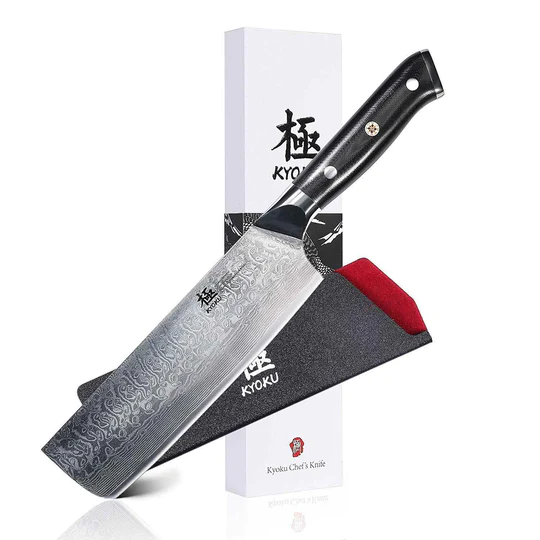
Knife Buzz offers independent product reviews on a wide range of knives used in the kitchen, home, and outdoors. We make it easy for you to find the right knife at the best price.